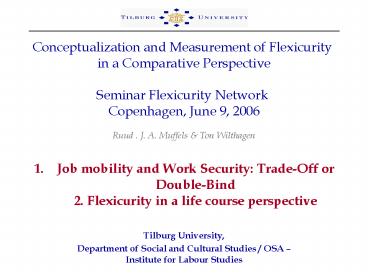Tilburg University, - PowerPoint PPT Presentation
1 / 16
Title:
Tilburg University,
Description:
Exit and (Re)-Entry: w.r.t. employment; working hours; quality of work ... homogenous clusters; use clusters in job mobility and exit/re-entry analyses ' ... – PowerPoint PPT presentation
Number of Views:1454
Avg rating:3.0/5.0
Title: Tilburg University,
1
Job mobility and Work Security Trade-Off or
Double-Bind2. Flexicurity in a life course
perspective
Conceptualization and Measurement of Flexicurity
in a Comparative Perspective Seminar
Flexicurity Network Copenhagen, June 9,
2006 Ruud . J. A. Muffels Ton Wilthagen
- Tilburg University,
- Department of Social and Cultural Studies / OSA
Institute for Labour Studies
2
Research focus in both projects
- Exploring the role and performance of welfare
states / policy regimes in maintaining
flexibility and work and income security using
longitudinal data (paneldata lifecourse-data) - Based on a dynamic approach define flexicurity
not in a static way but in a lifecourse
perspective - Define a broad set of dynamic outcome
indicators on both flexibility and security. Not
EPL but tenure or job mobility should be used as
indicators
3
Life course proofing of flexicurity arrangements
- Life-course proofing long-term effects of
working time arrangements such as part-time work,
career breaks (care and educational leave
schemes) and working in non-standard jobs. - Short and long-term effects on future wages and
income on participation in employment on
occupational level of jobs (careers), on job
quality, life satisfaction and health - Main underlying question Is there a trade-off
or a double bind relationship between the aims
of creating a flexible labor market and
safeguarding employment security for all people
over their life-time?
4
Dynamic indicators
- Flexibility
- Job-to-job mobility (internal, external)
- Professional status mobility
- Contractmobility
- Work Security
- Employment stability unempl. spells
- Exit and (Re)-Entry w.r.t. employment working
hours quality of work - Income security well-being quality of life
social participation integration (e.g. spells
of low/high income, well-being etc.)
5
Policy indicators availability and use of policy
measures
- Availability (opportunity set)
- EPL Labour Market and Social Security Policies
Firms HRM policies Self-regulation (market
individual civil society) - Usage/take-up
- Job tenure usage of LM/SS arangements Working
Time Options Vocational Training Quality of
Working Conditions - Construction of policy index on availability and
usage - Outcomes/effects assess differences across
countries and changes in policies over time find
homogenous clusters use clusters in job mobility
and exit/re-entry analyses
6
Table 1 The flexicurity combination of
employment regulation and work/income security in
different employment regimes
7
Two contrasting perspectives
- Trade-off thesis trade-off between flexibility
and security due to increased competition and a
process of skill-biased technological change - _ Flexicurity thesis double bind between
flexibility and security due to the
knowledge-based economy, flexibility is required
to be competitive and to afford work/income
security which on its turn is required to sustain
high levels of flexibility
8
Fig. 1. The theoretical relationship between
flexibility and security
High work security (exit low / (re-)entry high)
II Trade-off
I Flexicurity
Low flexibility (low job mobility)
High flexibility (high job mobility)
III Inflexicurity
IV Trade-off
Low work security (exit high / (re-)entry low)
9
Work security above EU-average
Corporatist, continental
Social-democratic
I Flexicurity (activating policies, high
employability)
II Trade-off (tightly regulated LM, active LM
policies)
Australian/ antipodean
Job Mobility below EU-average
Job Mobility above EU-average
Anglo-Saxon, Liberal
III Inflexicurity (tightly regulated, segmented
LM)
Transition countries
IV Trade-off (no regulation, no active LM
policies)
Southern, traditionalist
Work security below EU-average
Fig. 2 The contended location of the welfare
regimes in the flexicurity quadrant
10
Measures using ECHP
- Job Mobility (JM)
- Occupational mobility JM (based on occupational
class EGP - Contract Mobility CM (mobility between
employment contracts flexible job permanent
job self-employment) - Work Security (WS)
- Staying in employment
- Moving into more secure employment between t and
t1 for each of the pairs of years of observation - Add Income security Working conditions
11
Ten flexicurity indicators
- Flexibility
- 1. Internal job-to-job mobility
- 2. External job mobility
- 3. Occupational class mobility
- 4. Wage mobility (based on hourly real earnings)
- 5. Contract mobility
- Work and income security
- 6. Working time flexibility
- 7. Labour market stability and mobility
- 8. Job quality. Maintaining or moving into a
better job - 9. Social protection related mobility
- 10. Work-life balance related mobility (caring
educaton)
12
Measure for Work Security changes
- oorigin state ddestination state mnumber of
destination states - o,d 1 permanent job 2 flexible job 3
self-employment 4 out-of-work - - 100 nobody occupies a job because all
people moved out into non-work during the
observation period - 100 nobody stayed not-working because
everybody got a job during the observation period
13
Fig. 3 Indices for job mobility (JM), contract
mobility (CM) and work security (WS) by country
14
Fig. 4 Indices for job mobility (JM), contract
mobility (CM) and work security (WS) by regime
type
15
Work security above EU-average
DK
NL
Trade-off
Flexicurity
SD
UK
LIB
IRL
AU
COR
GE
BE
PO
FR
Job Mobility above EU-average
Job Mobility below EU-average
FIN
SOU
IT
Inflexicurity
SP
GR
Trade-off
Work security below EU-average
Fig. 5 The empirical derived location of twelve
European countries and four regime types within
the flexicurity quadrant
16
Conclusions and discussion
- Define dynamic outcome indicators for measuring
the attained balance between flexibility and
security - Define a broad set of dimensions of the
flexicurity concept like the ten dimensions
proposed here - Shift the focus from short-term to long-term or
life-course indicators and measure the effects of
particular life course events on future careers
(using panel and LC data) - Apply the measures on comparative data with a
sufficient number of countries to find country
clusters and to test whether policies matter and
whether regimes change over time































